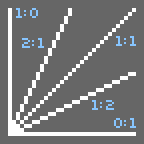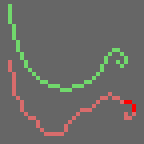Chat with us!
Discord: OpenGameArt
discord.gg/yDaQ4NcCux
Active Forum Topics - (view more)
- Sharing My Music and Sound FX - Over 2500 Tracks by Eric Matyas
- Change Username Requests by MedicineStorm
- Manic Minutes by Technopeasant
- Devkit: How to create standardized pixel art sprites for advanced game projects by Reactorcore
- Hey, I released a whole wave of various cool sprite packs here on OGA by Reactorcore
- Unity Character Controller - LPC Based by matzjj
- LFW - Experienced Music Composer - Sam Foster Sound by titanicpiano14
- Is it possible to have a offline version of this site like wikipedia does? by glitchart
Recent Comments - (view more)
- Re: Sokoban (100+ tiles) by rubikwizard
- Re: Haetae by MedicineStorm
- Re: Cosmic Cookie by itevee
- Re: N64 Stair Texture Template by Emerald Eel Ent...
- Re: N64 Stair Texture Template by LDAsh
- Re: Boy Npc by Blind Harpy Gamedev
- Re: Boy Npc by MedicineStorm
- Re: 8-Bit Sound Effects Library by artartart
Chapter 2: Lines and Curves
If you're not already an accomplished artist, the best way for you to start a drawing is to do it in pencil, the ink once you are satisfied, then color it. The same goes for the pixel-art: the first step in am image is the delimitation of its contours -- this step is called the "Lineart". Lineart is a very important step to achieve a good piece of pixel-art. A few pixels of your image can make up a large percentage of your image (as opposed to a drawing, where the scale allows for greater tolerance) so that an error of one or two pixels can give a make your character look really deformed. To be clear, lineart accuracy is C-R-U-C-I-A-L to the success of a pixel art.
1. Straight
 Lineart is composed mainly of lines and curves, and we'll start by talking about straight lines. Those of you who were listening in math class know that a line is characterized by its slope. It is the ratio of "change in y" to "change in x". For the purpose of this tutorial, we will represent this ratio as y:x. Thus, a perfect diagonal "bottom left" to "top right" line is a straight 1:1. Here are some simple guidelines and their coefficients to illustrate the idea.
Lineart is composed mainly of lines and curves, and we'll start by talking about straight lines. Those of you who were listening in math class know that a line is characterized by its slope. It is the ratio of "change in y" to "change in x". For the purpose of this tutorial, we will represent this ratio as y:x. Thus, a perfect diagonal "bottom left" to "top right" line is a straight 1:1. Here are some simple guidelines and their coefficients to illustrate the idea.
 In pixel-art, the lines that use these simple coefficients (0:1, 1:2, 1:1, 2:1 and 1:0), are called "perfect lines". They make your image look good because the eye can follow them without difficulty. They are not the only ones you can draw, you can for example make "intermediate" lines by alternating segments of length two with segments of length one (to simulate segments of length 1.5 -- see example image). The result is much less aesthetic (especially since the image is enlarged 4 times so you can see what happens) and shows why it's so important to use these kinds of lines sparingly. They still have their usefulness, though, and you will learn to embellish in a more advanced section of the course.
In pixel-art, the lines that use these simple coefficients (0:1, 1:2, 1:1, 2:1 and 1:0), are called "perfect lines". They make your image look good because the eye can follow them without difficulty. They are not the only ones you can draw, you can for example make "intermediate" lines by alternating segments of length two with segments of length one (to simulate segments of length 1.5 -- see example image). The result is much less aesthetic (especially since the image is enlarged 4 times so you can see what happens) and shows why it's so important to use these kinds of lines sparingly. They still have their usefulness, though, and you will learn to embellish in a more advanced section of the course.
2. Curves
Well, now you know how to draw lines, but you won't get far with just straight lines. Let us therefore look at curves, which are a more complex matter. Unlike a line, a curve can be good or bad.  There is only one rule to follow to achieve a smooth curve: the length of the segments will vary in a progressive manner, and you should avoid right angles. Well okay, that's two rules, but in fact the second is included in the first. For example: In Green, a you can see a nice curve that follows this rule perfectly. (From left to right, the lengths are 5 4 3 2 2 1 1 1 2 3 3 3 2 1 1 2 2 1 2 1 2 1 1). The red curve, on the other hand, is flouting it shamelessly (note the right angle that appears in the curve). In the end, a good technique to draw a curve is to draw the curve by hand (we get something like the red curve) and then go back and the change it until it meets "the rule". This ensures in advance that the curve will have the look you want. Well, that's it for curves. In conclusion, I leave you with some small examples of this course. The first is a dragon with curves illustrating the principles of outlined above; the second is a sword that shows that sometimes more angular lines (look at the tip and the pommel) can also be useful in some circumstances.
There is only one rule to follow to achieve a smooth curve: the length of the segments will vary in a progressive manner, and you should avoid right angles. Well okay, that's two rules, but in fact the second is included in the first. For example: In Green, a you can see a nice curve that follows this rule perfectly. (From left to right, the lengths are 5 4 3 2 2 1 1 1 2 3 3 3 2 1 1 2 2 1 2 1 2 1 1). The red curve, on the other hand, is flouting it shamelessly (note the right angle that appears in the curve). In the end, a good technique to draw a curve is to draw the curve by hand (we get something like the red curve) and then go back and the change it until it meets "the rule". This ensures in advance that the curve will have the look you want. Well, that's it for curves. In conclusion, I leave you with some small examples of this course. The first is a dragon with curves illustrating the principles of outlined above; the second is a sword that shows that sometimes more angular lines (look at the tip and the pommel) can also be useful in some circumstances.


I strongly recommend you practice some Lineart before you continue reading -- you'll need it to complete the rest of the course (as I will use the dragon above). If you have trouble, you can always use a scanned drawing.
